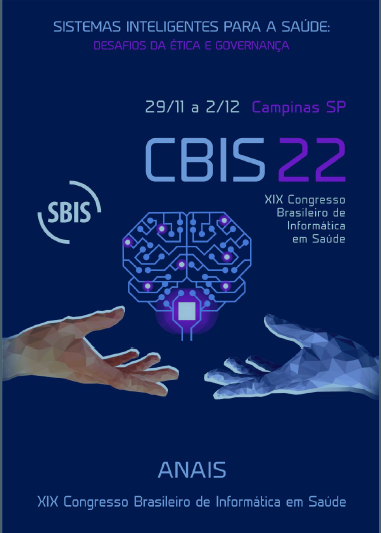Virtual Assistent in Men’s Health Education
DOI:
https://doi.org/10.59681/2175-4411.v15.iEspecial.2023.1087Keywords:
Health Education, Educational Technology, Men's HealthAbstract
Objective: This article aims to offer an effective method of health education through IChatSUS, an Intelligent Conversation Agent that can ask about men's health issues. Method: It was a descriptive observational with a qualitative and qualitative approach through a cross-sectional study. It was conducted with 20 participants to assess the Usability of IChatSUS and the user experience through the System Usability Score and User Experience Questionnaire. Results: Regarding the sample, 90% of the sample had access to the internet, 95% of the users had a technological profile and did not know about chatbots. The usability of IChatSUS revealed a need for improvement. When evaluating the User Experience, the results were optimistic. Conclusion: The use of health education IChatSUS had an excellent performance but reveals the need for maintenance. It is necessary to expand the public and environment of the ChatSUS’s application for greater use of it.
References
Araújo MG, Lima GA, Holanda CS, Carvalho JB, Sales LK. Professional opinion on the effectiveness of the National Policy of Comprehensive Health Care for Men. Escola Anna Nery - Revista de Enfermagem. 2014;18(4). Doi:10.5935/1414-8145.20140097.
Brito RS, Santos DLA. Barriers to implementing health care programs for male publics: health professionals’ views. UERJ Nursing Journal, 2014;21(5);654-9. Available in: https://www.e-publicacoes.uerj.br/index.php/enfermagemuerj/article/view/10044/7832.
Dourado JL, Alves RS. Prisoner’s health overview: access difficulties to healthcare. Academia Paulista de Psicologia. 2020;39(96). Doi:10.5935/2176-3038.20190005.
Silva AS, Barbosa MG, Souza AP, Rocha AA, Carvalho TW, Oliveira Lins SR. Health of man: difficulties found by male population to access family health services (USF). Brazilian Journal of Health Review. 2020;3(2):1966-1989. Doi:10.34119/bjhrv3n2-055.
Su MH, Wu CH, Huang KY, Hong QB, Wang HM. A chatbot using LSTM-based multi-layer embedding for elderly care. Proceedings of the 2017 International Conference on Orange Technologies, ICOT 2017. 2017; 70-74. Doi: 10.1109/ICOT.2017.8336091.
Melo ECA, Enders BC, Basto ML. Plataforma PEnsinar®: a learning tool for teaching the nursing process. Rev Bras Enferm [Internet]. 2018;71(Suppl 4):1522-30. [Thematic Issue: Education and teaching in Nursing]. Doi: http://dx.doi.org/10.1590/0034-7167-2016-0411.
King AC, Campero I, Sheats JL et al. Testing the comparative effects of physical activity advice by humans vs. computers in underserved populations: The COMPASS trial design, methods, and baseline characteristics. Contemporary Clinical Trials. 2017;61:115-125. Doi:10.1016/j.cct.2017.07.020.
Owens OL, Felder T, Tavakoli AS et al. Evaluation of a Computer-Based Decision Aid for Promoting Informed Prostate Cancer Screening Decisions Among African American Men: iDecide. American Journal of Health Promotion. 2018;33(2):267-278. Doi:10.1177/0890117118786866.
Wu Y, Samant D, Squibbs K, Chaet A, Morshedi B, Barnes LE. Design of interactive cancer education technology for Latina farmworkers. In: 2014 Systems and Information Engineering Design Symposium (SIEDS). IEEE; 2014. doi:10.1109/sieds.2014.6829908.
Jack B, Bickmore T, Hempstead M et al. Reducing Preconception Risks Among African American Women with Conversational Agent Technology. The Journal of the American Board of Family Medicine. 2015;28(4):441-451. Doi:10.3122/jabfm.2015.04.140327.
Cursino JRV, Campos Filho AS, Calista AA, Nascimento, JEM. An Integrative Review on the Use of Chatbot to Support Health Education. Rev. Saúde Digital Tec. Educ. 2020;5(1):108-122. Doi:10.36517/resdite.v5.n1.2020.a8
Bangor A, Kortum PT, Miller JT. An Empirical Evaluation of the System Usability Scale. International Journal of Human-Computer Interaction. 2008;24(6):574-594. doi:10.1080/10447310802205776.
Almayyan W, Alsuwaidi M, AlGhannam BA. Perceived Usability of Arabic System Usability Scale (A-SUS): Faculty Members’ Perspective of Smart PAAET Application. International Journal of Computer Applications. 2021;183(37):17-22. Doi:10.5120/ijca2021921757.
Laugwitz B, Held T, Schrepp M. Construction and Evaluation of a User Experience Questionnaire. In: Lecture Notes in Computer Science. Springer Berlin Heidelberg; 2008:63-76. doi:10.1007/978-3-540-89350-9_6.
IBGE, Instituto Brasileiro de Geografia e Estatística [Internet]. Educação. 2019. Available in: chrome-extension://efaidnbmnnnibpcajpcglclefindmkaj/https://biblioteca.ibge.gov.br/visualizacao/livros/liv101736_informativo.pdf.
IBGE, Instituto Brasileiro de Geografia e Estatística [Internet]. Uso de Internet, televisão e celular no Brasil. 2019. Available in: chrome-extension://efaidnbmnnnibpcajpcglclefindmkaj/https://biblioteca.ibge.gov.br/visualizacao/livros/liv101794_informativo.pdf
Downloads
Published
How to Cite
Issue
Section
License
Copyright (c) 2023 Amadeu Sá de Campos Filho, Jose Ricardo Vasconcelos Cursino, Thomé Décio Pinheiro Barros Júnior, Évelyn Cristina Morais Pessôa Lima

This work is licensed under a Creative Commons Attribution-NonCommercial-ShareAlike 4.0 International License.
Submission of a paper to Journal of Health Informatics is understood to imply that it is not being considered for publication elsewhere and that the author(s) permission to publish his/her (their) article(s) in this Journal implies the exclusive authorization of the publishers to deal with all issues concerning the copyright therein. Upon the submission of an article, authors will be asked to sign a Copyright Notice. Acceptance of the agreement will ensure the widest possible dissemination of information. An e-mail will be sent to the corresponding author confirming receipt of the manuscript and acceptance of the agreement.

